
Teucrium is a cosmopolitan genus of flowering plants in the family Lamiaceae, commonly known as germanders. Plants in this genus are perennial herbs or shrubs, with branches that are more or less square in cross-section, leaves arranged in opposite pairs, and flowers arranged in thyrses, the corolla with mostly white to cream-coloured, lobed petals.

Teucrium polium, known popularly as felty germander, is a sub-shrub and herb native to the western Mediterranean region. Its flowers are small and range from pink to white, and its leaves are used in cooking and for medicine.

Teucrium scorodonia, common name the woodland germander or wood sage, is a species of flowering plant in the genus Teucrium of the family Lamiaceae. It is native to Western Europe and Tunisia, but cultivated in many places as an ornamental plant in gardens, and naturalized in several regions.

Teucrium marum, commonly known as cat thyme or kitty crack, is a species of germander. Its small, oval leaves give it a thyme-like appearance, but the musty scent is quite unlike the delicate aroma of thyme. Cat thyme is a mounding, tender perennial with grey-green leaves tipped by fragrant pink flowers in summer.

Teucrium chamaedrys, the wall germander, is a species of ornamental plant native to Mediterranean region of Europe and North Africa, and to the Middle East as far east as Iran. It was historically used as a medicinal herb for the treatment of gout and sometimes as a component of Venice treacle.
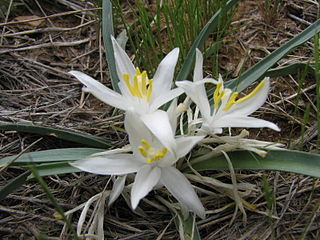
Leucocrinum montanum, commonly known as the sand lily, common starlily or mountain lily, is the only species in the monotypic genus Leucocrinum, placed in the family Asparagaceae, and subfamily Agavoideae. It is native to the western United States, primarily in the Rocky Mountains and the Great Basin.
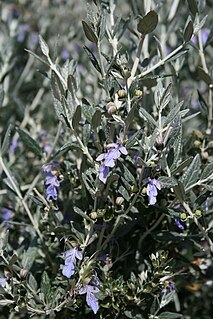
Teucrium fruticans is a species of flowering plant in the mint family Lamiaceae, native to the western and central Mediterranean. Growing to 1 m (3 ft) tall by 4 m (13 ft) wide, it is a spreading evergreen shrub with arching velvety white shoots, glossy aromatic leaves and pale blue flowers in summer.

Apterona helicoidella is a moth of the Psychidae family. It is widely distributed in Europe, from Portugal through most of central Europe and the Alps, up to the Ural. It is also found on the Balkan and in Turkey. It was introduced in the United States by accident during the 1940s. It is now found in many mid-Atlantic states, including Pennsylvania, and has also been reported in the Pacific coastal states, as well as Colorado, Michigan, Nevada, Utah and Idaho. It has been collected in Ontario as well.

Teucrium cubense is a species of flowering plant in the mint family known by the common names small coastal germander and dwarf germander. It is native to a section of the Americas that includes the southwestern - south-central United States, parts of the Caribbean, Mexico, Costa Rica, and southern South America. In general, the plant has lobed leaves and a flower corolla with a broad lower lobe and smaller lateral lobes. The flower may be white or blue-tinged with purple speckles.
Teucrium glandulosum is a species of flowering plant in the mint family known by the common names sticky germander and desert germander. It is native to the Sonoran Desert of Arizona, Baja California, Baja California Sur, and San Bernardino County in California. It grows in rocky desert habitat such as canyons. The plant produces three-lobed leaves on its branching stem. The flowers have purple-streaked white corollas up to 2 centimeters long each with a large lower lobe and smaller lateral lobes. The inside of the flower is very hairy.

Aspilapteryx limosella is a moth of the family Gracillariidae. It is found from Germany and Poland to the Iberian Peninsula, Italy and Greece. It is also found in central and southern Russia.

Teucrium botrys, the cutleaf germander or cut-leaved germander is a low to short downy annual, sometimes biennial, plant. It was noted by Carl Linnaeus in 1753 and is classified as part of the genus Teucrium in the family Lamiaceae. It has oval, but deeply cut leaves, which appear almost pinnate in form. Its flowers are two-lipped but with the upper lip diminutive. They are pink to purple and form from the stem at the base of the leaves, in whorls. It is in flower in the northern hemisphere from June to October. It prefers limy soils and bare stony ground. It is native to Western Europe, especially France and Germany. It has been introduced into north-eastern North America.

Teucrium racemosum, also commonly referred to as either the grey germander or forest germander, is a species of flowering plant in the family Lamiaceae. It is endemic to Australia and is found in all mainland states, the Northern Territory and the Australian Capital Territory. It grows in floodplains, dry lake beds and open woodlands. A perennial herb, it has four-sided, densely hairy stems, narrow egg-shaped leaves, and white flowers usually arranged singly in leaf axils. It grows to be between 15 and 40 cm tall.

Teucrium corymbosum, commonly known as forest germander, is a species of flowering plant in the family Lamiaceae and is native to Australia and New Guinea. It is a perennial herb or subshrub densely covered with glands and with narrow egg-shaped leaves usually with toothed edges, and groups of mostly up to ten white flowers.
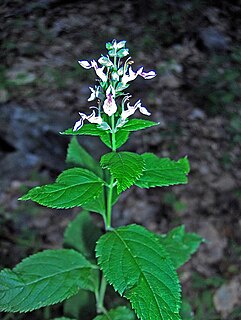
Teucrium canadense, commonly known as Canada germander, American germander or wood sage, is a perennial herb in the family Lamiaceae. It is native to North America where it is found across the contiguous states of the United States and in much of Canada.
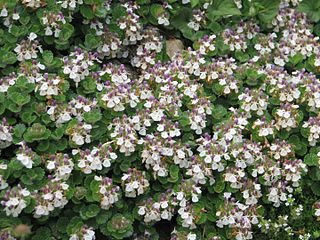
Teucrium pyrenaicum, the Pyrenean germander, is a species of germander native to the Pyrenees. It has gained the Royal Horticultural Society's Award of Garden Merit.

Teucrium argutum, commonly known as native germander, is a species of flowering plant in the family Lamiaceae, and is endemic to eastern Australia. It is a perennial herb often suckering, with hairy, broadly egg-shaped leaves with toothed or wavy edges, and pink-purple flowers.
Teucrium grandiusculum is a species of flowering plant in the family Lamiaceae and is endemic to central Australia. It is a perennial herb or shrub with toothed, egg-shaped leaves and white flowers.
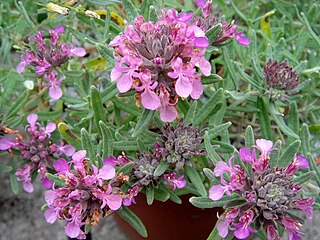
Teucrium ackermannii, the silver germander, is a flowering plant in the family Teucrioideae. It is of unknown origin and naming.
















